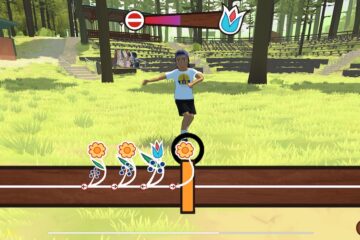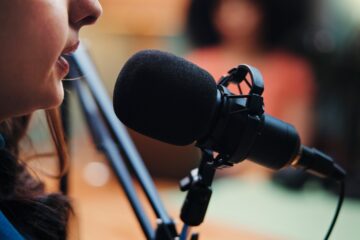Native American net to launch next month
Indian country’s first satellite radio network is set to launch Oct.
31 with a weekday hourlong anthology of native programming
from producers around the country.
Supported by a 27-month, $459,000 grant from CPB, American Indian Radio
on Satellite (AIROS) will link about 25 tribal stations in 10 states
— many on reservations where radio is the sole telecommunications
service. AIROS directors see the network as a first step toward an ambitious
goal: building and linking stations on 250 Indian reservations.
“It’s historic,” says Susan Braine, an Assiniboine Sioux, who
has been the network’s one-woman staff since January. “It gives
us the ability to communicate with each other in a way mainstream America
has taken for granted — has used and abused! It opens so many new
doors for native communities to talk to each other, to learn from each
other, to help each other.” Besides one annual conference and occasional
regional meetings, there are scant opportunities for Indians from different
parts of the country to unite for discussion, Braine says.
The satellite service will also offer a first-ever product: a flow
of programming tailored to the needs of native listeners. Beyond occasional
features or news items on the national networks, the only native-content
fare on national radio is National Native News, a daily five-minute
report produced by Alaska Public Radio Network. Earlier this year, after
airing a pilot of Native America Calling, a talk show AIROS will
distribute, the show’s staff discovered “people are very hungry
for this material,” says Co-executive Producer D’Anne Hamilton (also
producer of National Native News). “They’ve never had a
chance to hear people in Alaska, [for example]. They want to hear other
native people on the air, hear about the way they do things, make that
connection . . . It’s one of the things native people have been starving
for.” During the five-day period KDLG in Dillingham, Alaska, aired
the Calling pilots, listeners called the station to voice their
opinions. Says Station Manager K.C. Jackson: “They didn’t want
to be on the air, but they wanted me to know they didn’t agree with
what was said.”
By beaming programming to stations, AIROS aims to free up local staff
so the stations can produce more content for the satellite. “That’s
the main goal — getting stations to start producing,” Braine says.
Toward that goal, AIROS directors recently decided AIROS would be strictly
a distributor and stay out of the production business.
AIROS is jointly sponsored by the Native American Public Broadcasting
Consortium (NAPBC), based in Lincoln, Neb., and the Indigenous Communications
Association or ICA), a New York-based network of native-owned stations
that has set as one goal the building of 250 native-owned stations.
Objectives: programs, hookup
Initially, AIROS will uplink one hour of programming five days per
week — a compilation of material from archives Braine started building
in January. Sometime before February, AIROS plans to launch Native
America Calling. Also in the pipeline is Indigenous Voices,
a weekly magazine to be produced by Peggy Berryhill (Spirits of the
Present). And, Braine is considering uplinking an hour of special-interest
programming not necessarily intended for live broadcast, such as Sioux-language
programming.
To date, AIROS has uplinked the Calling pilots — broadcast
from this summer’s Unity journalism conference in Atlanta; and its own
pilots — a broadcast of a Winter Council meeting on sovereignty,
and a meeting of tribal leaders with President Clinton.
In addition to delivering programming, AIROS is completing the technical
interconnections needed to distribute programming to tribal stations.
Last year, NAPBC won a Public Telecommunications Facilities Program
grant to put in downlinks at four stations; by the end of October, when
AIROS goes up, the last of the four will have an operating dish tunable
to the C- and Ku- bands. Of the total group of stations, “there
are a varying number that have a downlink that may be not working for
some reason or another, or because they can’t afford the D/I [distribution/interconnection]
fee and are not using it,” Braine says. She estimates at least 20 of
the 25 stations will be able to pull programming off the satellite once
AIROS hits the air.
Although AIROS stations may eventually use the less expensive Ku-band,
their dishes initially will be tuned to the C-band, because most of
them have C-band dishes, Braine said.
Will seek fee waivers
Some observers say AIROS and online services developed over the past
few years by Indians herald the start of a new industry and way of life
for native communities. ICA head Ray Cook sees radio as a first-wave
technology, paving the way for telecommunications centers in native
communities, and for individuals to gain access to the career fields
of telecommunications or performing arts. ICA is helping 18 native communities
get federal grants to build stations.
The organization is also working with the Public Radio Forum, an organization
of 16 public radio organizations that serve minorities and rural listeners,
to ensure native communities are not left behind in the rush to stake
out space on the national information infrastructure.
In the fall, Cook and and Latino radio satellite service Satelite will
propose that NPR’s D/I Committee waive interconnect fees for stations
that carry primarily non-English language programming.
There are fewer than 15 such stations serving Hispanic communities
and only a handful of others, according to Hugo Morales, executive director
of Radio Bilingue, a California station group that operates Satelite.
“These stations are out of the main programming loop, and the way
to bring them into the system is to make the satellite service be as
least costly to them as possible,” says Morales. “It’s in the
interests of the entire system to have a diversity of services.”
Ultimately, the two networks would like NPR to subsidize two satellite
channels for their use. Before making that proposal, however, public
radio’sLegislative Forum — which recently approved the idea —
must resolve the question of how to justify subsidies for Satelite and
AIROS, but not other groups. “There are a lot of issues,” said Morales.
“Who else could fit in? Are we opening gates to everybody? Where do
you draw the line?”
With its own channel, AIROS might broadcast programming intended strictly
for indigenous peoples, as well as the broad-appeal content funded by
CPB, says Cook. It might sub-lease space on the channel as well, he
said. For Cook, a channel is a matter of rights: “Radio signals
are now becoming resources like . . . coal, water, uranium. Indians
have reserved rights to be the first people to take advantage of [resources]
in our region,” he said. “We’ve got NPR, PRI and ABC bombarding
our territories with their signals. Now there’s a movement afoot, saying,
`We better make them pay for it.’ Like the telephone company, they can’t
put lines across our territory just because it’s easy, without giving
us a cut.”
“Just put good stuff on”
One of the challenges facing AIROS will be acquiring enough programming.
Cook estimates there are fewer than 20 native producers at the local
level. There are probably a dozen or so people who produce national
programming on native topics, he says. Beyond the dearth of programmers,
tribal stations are so poor that they can barely afford adequate staffing,
never mind production, Braine says.
The tremendous geographic and cultural diversity of the native population
in the United States could present a different sort of challenge, making
it difficult to develop a programing package with wide or universal
appeal. At KABR in Magdalena, N.M., Patsy Apachito, for example, says
her listeners were lukewarm about Native America Calling pilots
because they felt the programming was “too much out there” —
not relevant to their concerns. Instead of programs on gaming or the
use of Indian ”mascots” (such as Washington, D.C.’s “Redskins”
football team), her community needs to hear about topics such as welfare
reform, she says. Apachito’s KABR, Magdalena, NM, serves 6,000 listeners.
Braine acknowledges that the diversity is a factor, but says ultimately
she’s not concerned. She questions whether it’s possible to come up
with a true listener profile that can determine program schedules. ”You
just put good stuff [on the satellite] and try to make it as diverse
as possible so you appeal to a wide range of interests, and if people
don’t like it they can turn the damn radio off, and if they like it,
they’ll listen . . .”
Although AIROS wants to foster connections among indigenous peoples,
it is targeting nonnative listeners as well, and nonnative stations
have expressed an interest, Braine says. AIROS programming will help
nonnatives develop knowledge and understanding of Indians, she says.
“Native Americans tend to get clumped into all the rest of minorities,
and we’re really a lot different because of the sovereignty issue,”
she says. “That’s one thing Americans really [have] a responsibility
to understand a lot better — because of those treaties.”





